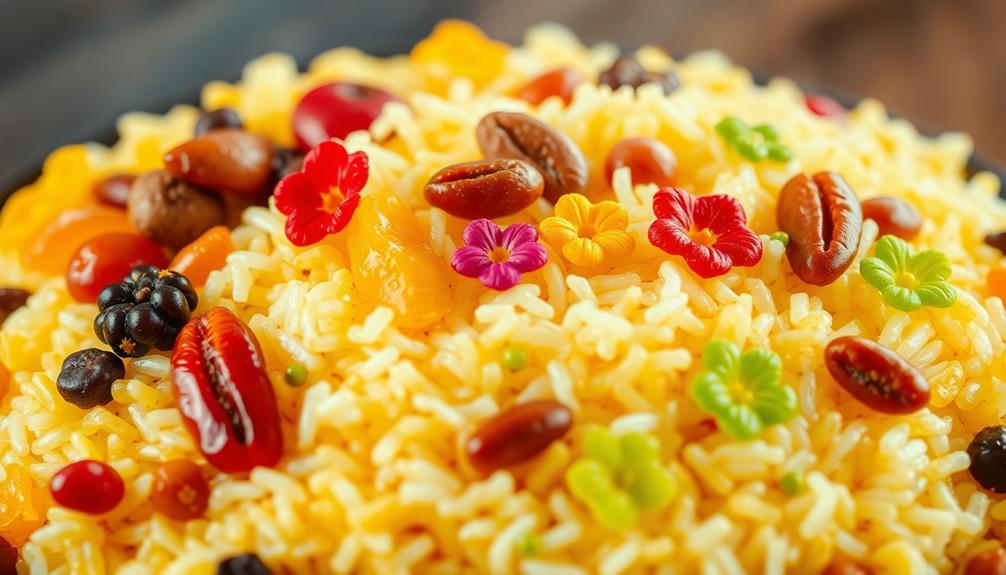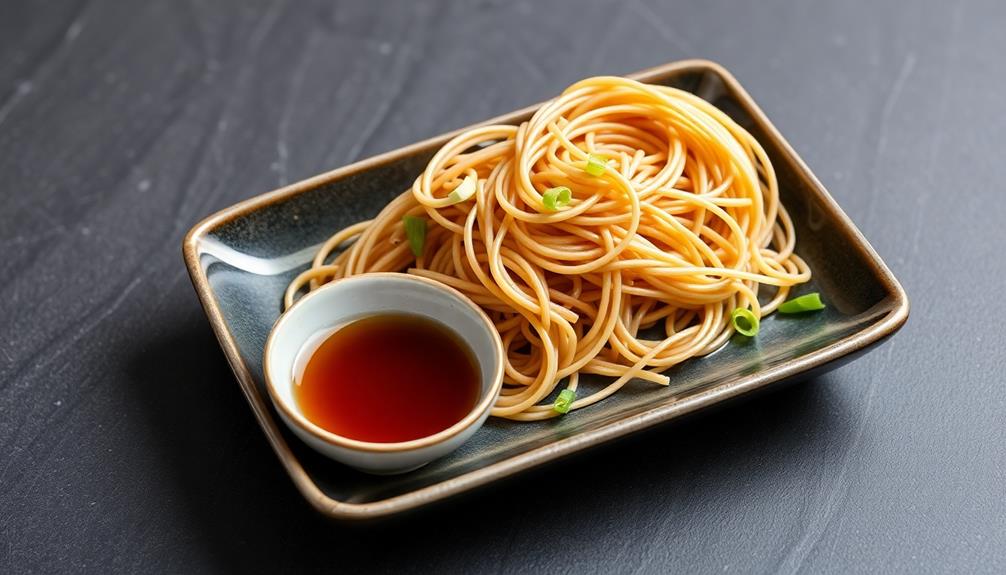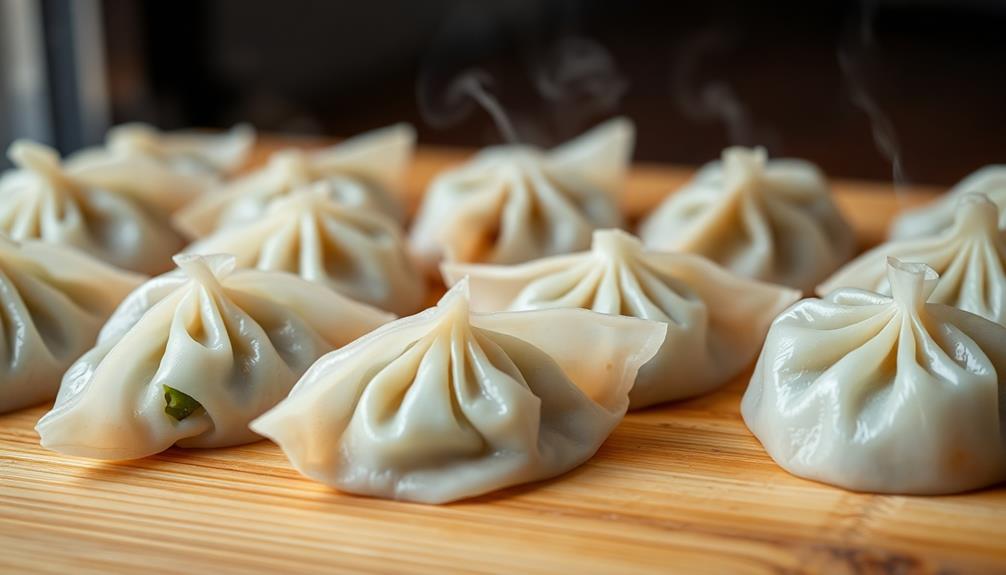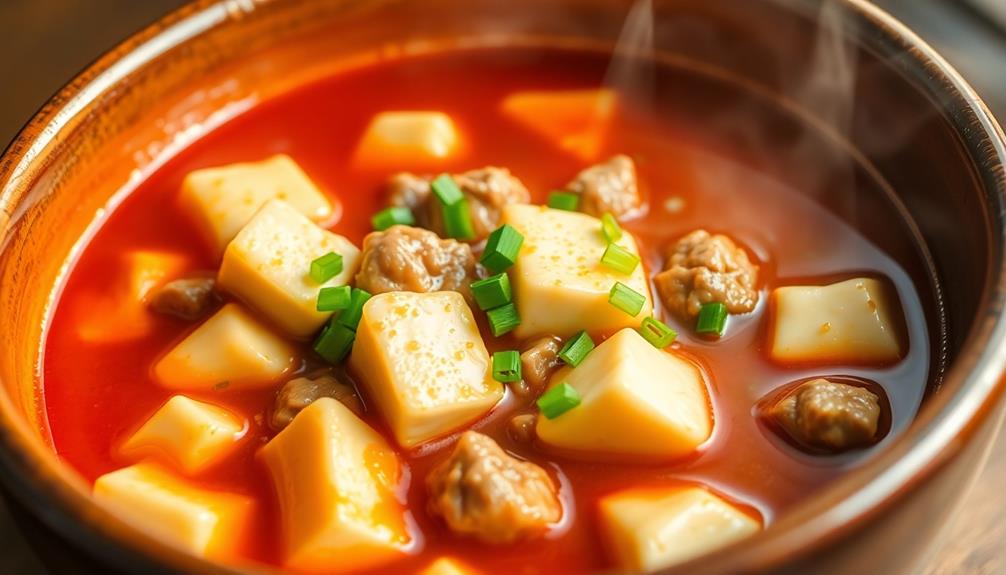Eight Treasure Rice is a classic Chinese dish you'll absolutely adore! It dates back to the Ming Dynasty, when it was an imperial treat. Nowadays, it's a cherished part of Chinese cuisine, often served during festivals to symbolize prosperity. The "Eight Treasure" refers to the eight different ingredients, like dried fruits, nuts, and seeds, that create a symphony of flavors and textures. Cooking up this traditional recipe takes some skill, but the end result is worth it – a colorful, delicious dish that'll have you coming back for more. And if you keep reading, you'll discover the mouthwatering details behind this timeless culinary treasure.
Key Takeaways
- Eight Treasure Rice is an iconic Chinese dish that originated during the Ming Dynasty as an imperial delicacy.
- The dish's name symbolizes abundance and prosperity, and it is often served during festivals and special occasions.
- The core ingredients include glutinous rice, dried fruits, nuts, and seeds, creating a harmonious balance of flavors and textures.
- Proper cooking techniques, such as thorough rinsing and soaking of the rice, are essential for achieving the desired texture and flavor.
- Eight Treasure Rice can be enjoyed as a dessert or a festive dish, often paired with tea for a balanced meal.
History
According to historical accounts, Eight Treasure Rice has been a beloved dish in Chinese cuisine for centuries. The origins of this delectable rice dish can be traced back to the Ming Dynasty, when imperial chefs would create elaborate rice concoctions fit for the Emperor's table.
Over time, the recipe evolved, and Eight Treasure Rice became a cherished part of Chinese culinary traditions.
The name "Eight Treasure" refers to the eight different ingredients that are typically used in the dish, which can include dried fruits, nuts, seeds, and even candied melon. These vibrant components come together to form a harmonious and visually stunning rice creation.
Preparing Eight Treasure Rice was once a laborious task, but modern cooks have streamlined the process, making it easier for families to enjoy this timeless delicacy.
Today, Eight Treasure Rice remains a beloved dish, often served at special occasions and family gatherings. Its rich history and delightful flavors continue to captivate food enthusiasts around the world.
Recipe
Eight Treasure Rice is a classic Chinese dish that combines various ingredients to create a visually stunning and flavorful meal. This dish isn't only delicious but also represents the abundance and prosperity associated with the number eight.
The combination of glutinous rice, dried fruits, nuts, and other treasured ingredients makes this dish a centerpiece of many celebratory meals. Its vibrant colors and textures create a harmonious and satisfying dining experience.
- 2 cups glutinous rice, soaked in water for at least 4 hours
- 1/2 cup dried lotus seeds
- 1/2 cup dried longan
- 1/4 cup dried jujube (red dates)
- 1/4 cup dried apricots, chopped
- 1/4 cup roasted peanuts
- 1/4 cup dried cranberries
- 1/4 cup cooked chickpeas
- 2 tablespoons sugar
- 1 teaspoon salt
- 1/4 cup water
Drain the soaked glutinous rice and transfer it to a steamer. Steam the rice for 30 minutes, or until cooked through.
In a separate bowl, combine the dried lotus seeds, longan, jujube, apricots, peanuts, cranberries, and chickpeas. Add the sugar and salt, and mix well.
Fluff the cooked glutinous rice and gently fold in the fruit and nut mixture, along with the 1/4 cup of water. Transfer the eight treasure rice to a serving dish and enjoy.
To ensure the best results, it's important to soak the glutinous rice for at least 4 hours to achieve the desired texture.
Additionally, feel free to adjust the quantities of the dried fruits and nuts to suit your personal preferences. This dish can be served warm or at room temperature, making it a versatile choice for various occasions.
Cooking Steps
Rinse that rice real good to get rid of any extra starch.
Let it soak for half an hour so it's nice and plump.
Then, crank up the heat and cook it until it's perfect!
Next, you'll add all sorts of tasty ingredients to make your eight treasure rice extra special.
Yum, can't wait to dig in while it's still hot!
Step 1. Rinse Rice Thoroughly

Before starting the cooking process, you'll want to thoroughly rinse the rice. This important step helps remove any excess starch and impurities, ensuring your eight treasure rice turns out perfectly.
To do this, place the rice in a fine-mesh strainer and run it under cool, clean water, gently stirring the grains with your fingers. You'll see the water become cloudy as the starch is released. Keep rinsing until the water runs clear – this typically takes 2-3 minutes.
Once the rice is clean, you're ready to move on to the next step. Rinsing the rice well gives it a better texture and helps the flavors meld together beautifully in the final dish. Plus, it's a simple task that only takes a minute, so don't skip this crucial part of the cooking process.
With the rice rinsed, you can now start assembling the eight treasure rice for an amazing flavor experience.
Step 2. Soak Rice for 30 Minutes
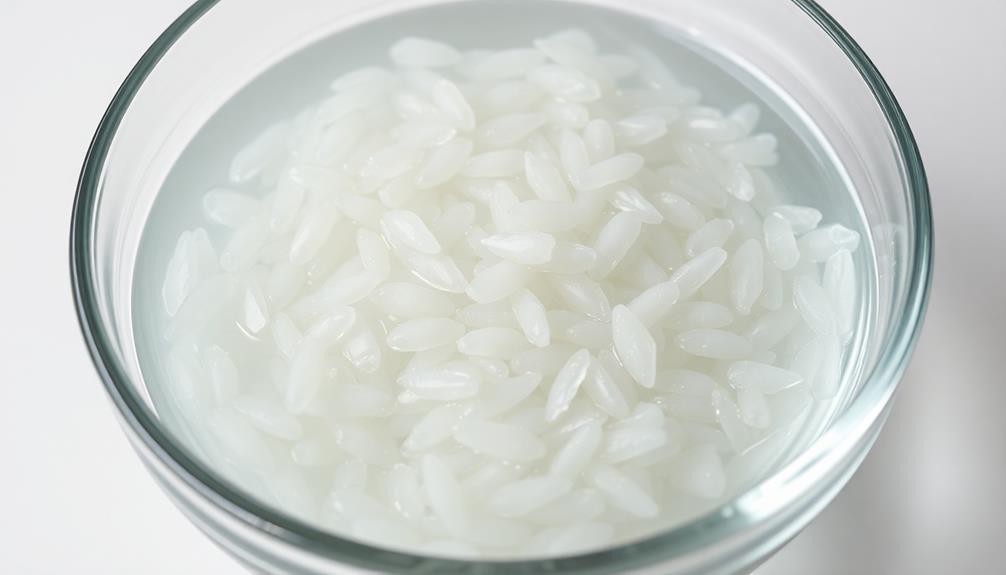
After rinsing the rice, you'll want to soak it for about 30 minutes. This step is crucial because it helps the grains become more tender and fluffy. Soaking also allows the rice to absorb more water, which means it'll cook more evenly.
Simply place the rinsed rice in a bowl and cover it with fresh, cool water. Let it sit for half an hour, giving the rice a chance to drink up all that lovely H2O. This extra hydration makes the rice easier to cook and prevents it from becoming dry or clumpy later on.
While the rice is soaking, you can start chopping up the other tasty ingredients that will go into your Eight Treasure Rice dish. This extra prep time will make the rest of the cooking process smooth sailing.
When the 30 minutes are up, drain the rice and you're ready for the next step. Get excited – your delicious rice medley is one step closer to completion!
Step 3. Cook Rice at High Heat
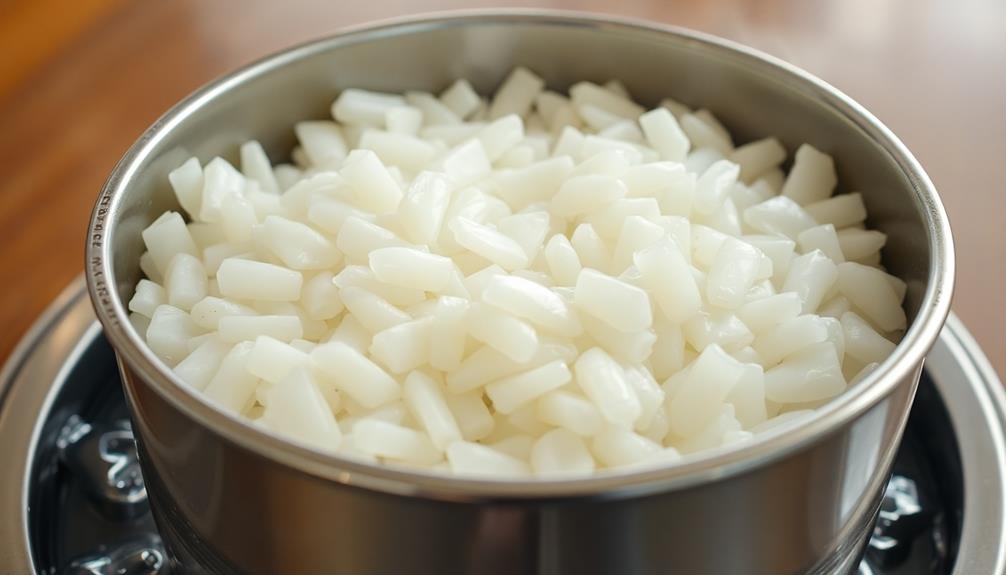
Once the rice has finished soaking, you'll want to drain it thoroughly. Grab a fine-mesh strainer and carefully pour the rice into it, making sure to get rid of all that excess water.
With the rice nice and dry, it's time to get cooking!
Grab your trusty pot and crank up the heat to high. That's right, we're going full-throttle today! Carefully pour the rice into the hot pot and let it sizzle. You'll want to stir the rice constantly with a wooden spoon to prevent any sticking or burning.
Keep that up for about 2-3 minutes, until the grains start to look a little translucent and toasty.
Now it's time to add the water. Carefully pour in the exact amount called for in the recipe – no more, no less! Bring the pot to a boil, then immediately reduce the heat to low, cover, and let the rice simmer away for about 15 minutes.
Resist the urge to peek, as you don't want to let all that precious steam escape!
Step 4. Add Flavorful Ingredients
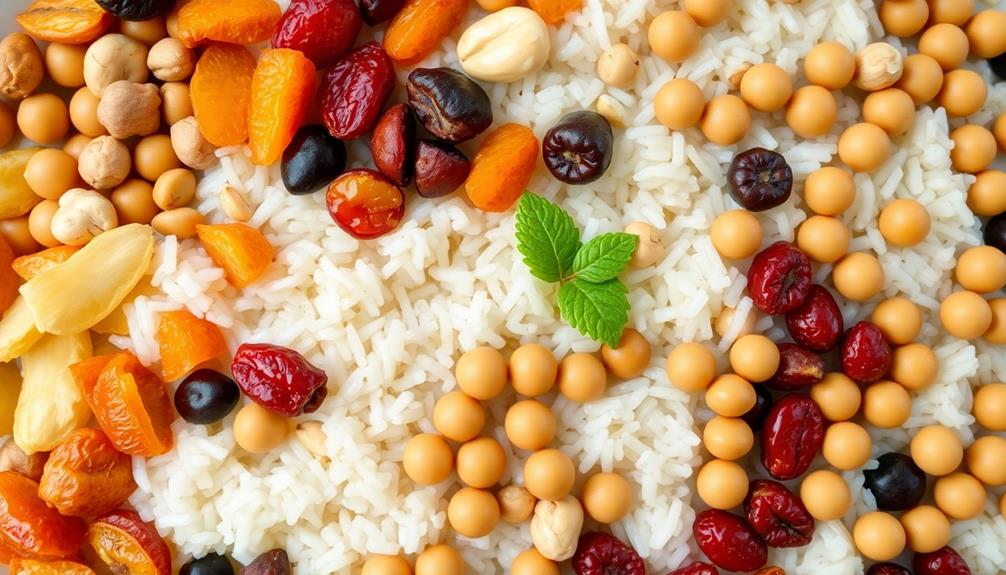
With the rice simmering away, it's time to add the flavorful ingredients that will transform this dish into a true taste sensation.
First, grab a handful of dried fruits – maybe some raisins, chopped apricots, and a few dates. Chop them up and toss them into the pot. Their natural sweetness will complement the savory rice perfectly. Next, sprinkle in a pinch of cinnamon or cardamom to enhance the warm, spiced notes of the dish. As the fruits cook, they’ll soften and release their flavors, mingling beautifully with the other ingredients. Interestingly, while dishes like this have their roots in Middle Eastern cuisine, the combination of rice and beans can bring to mind the **Costa Rican Gallo Pinto origin**, a staple meal that also blends simple ingredients to create bold, comforting flavors.
Next, let's liven things up with some crunchy add-ins. Toasted almonds, chopped cashews, and a sprinkle of toasted sesame seeds will all do the trick. They'll add wonderful texture and nutty flavors to every bite.
Don't forget the fresh herbs! Finely chop some fragrant cilantro and green onions, then gently stir them into the rice. Their bright, vibrant flavors will really make the dish pop.
Step 5. Serve Immediately While Hot
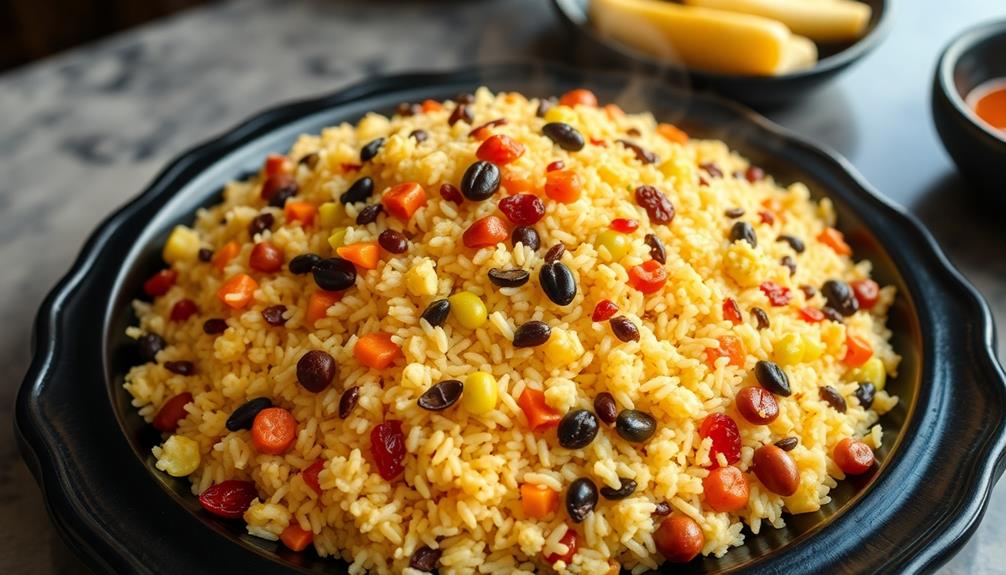
The moment has arrived to serve this aromatic and vibrant Eight Treasure Rice. Don't wait another minute – it's best enjoyed piping hot! Grab your bowls and spoons, and let's dive in.
First, use a large serving spoon to scoop generous portions of the rice into each bowl. Make sure to get a mix of all the colorful ingredients – the glistening raisins, the crunchy peanuts, the chewy dried apricots, and the vibrant green peas. Mmm, can you smell that heavenly aroma? Once the rice bowls are filled, top them with a generous drizzle of the aromatic curry sauce. The combination of flavors and textures is simply divine. As you take a deep breath and savor the heavenly aroma, you might catch a whiff of something else in the air – the distinct scent of stinky tofu. But don’t let that deter you from enjoying this delicious and satisfying meal. The stinky tofu adds a unique and savory element to the experience, making it a truly unforgettable dish.
Now, before you take your first bite, be careful – the rice is steaming hot! Gently blow on a spoonful to cool it down. Then, savor each mouthful, letting the flavors dance on your tongue. The sweet, the savory, the nutty – it's a flavor explosion in every bite!
Don't forget to share this delightful dish with your family and friends. They'll be amazed by the stunning presentation and delighted by the delicious taste. Enjoy!
Final Thoughts
As you savor the last few bites of this delightful Eight Treasure Rice, you can't help but reflect on the symphony of flavors that have danced across your palate. The mix of fragrant jasmine rice, chewy dried fruits, and crunchy nuts has created a truly unique and memorable dish. You feel a sense of satisfaction, knowing that you've mastered a traditional Chinese recipe that's bursting with personality.
Looking back, you're impressed by how the various ingredients came together seamlessly, each one complementing the others. The sweet and tart notes of the dried longans and lychees balance the earthy undertones of the lotus seeds and chestnuts.
The toasted peanuts and pine nuts add a delightful crunch, while the goji berries provide a pop of color and a subtle hint of tartness.
As you push your empty bowl aside, you can't wait to try your hand at creating this dish again, perhaps experimenting with different dried fruits or nuts to put your own spin on this time-honored classic.
Frequently Asked Questions
Is Eight Treasure Rice a Type of Chinese Cuisine?
Yes, eight treasure rice is a type of Chinese cuisine. It's a traditional rice dish that features a variety of ingredients like dried fruits, nuts, and other savory and sweet components.
What Are the Eight Treasures Used in the Dish?
The eight treasures used in the dish typically include a variety of dried fruits, nuts, and seeds. These treasures are carefully selected to create a harmonious blend of flavors and textures.
How Long Does It Take to Prepare Eight Treasure Rice?
Preparing this dish takes some time, but it's worth it. You'll need around 45 minutes to an hour to get everything chopped, cooked, and assembled. Don't be daunted – the end result is a delightful, flavorful rice dish.
Is Eight Treasure Rice Suitable for Vegetarians or Vegans?
Yes, eight treasure rice can be suitable for vegetarians or vegans, depending on the specific ingredients used. You'll want to carefully check the recipe to ensure it doesn't contain any animal-based products.
Can Eight Treasure Rice Be Served as a Main Dish or Dessert?
You can serve this dish as either a main course or a dessert, depending on your preferences and the other items in your meal. It's a versatile option that can be tailored to your needs.
